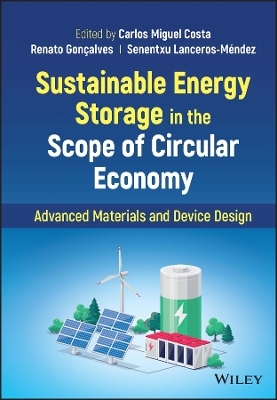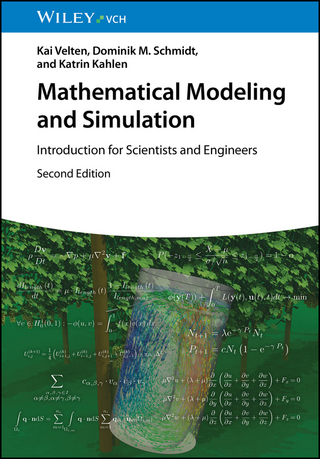
Sustainable Energy Storage in the Scope of Circular Economy
John Wiley & Sons Inc (Verlag)
978-1-119-81768-0 (ISBN)
Comprehensive resource reviewing recent developments in the design and application of energy storage devices
Sustainable Energy Storage in the Scope of Circular Economy reviews the recent developments in energy storage devices based on sustainable materials within the framework of the circular economy, addressing the sustainable design and application of energy storage devices with consideration of the key advantages and remaining challenges in this rapidly evolving research field.
Topics covered include:
Sustainable materials for batteries and fuel cell devices
Multifunctional sustainable materials for energy storage
Energy storage devices in the scope of the Internet of Things
Sustainable energy storage devices and device design for sensors and actuators
Waste prevention for energy storage devices based on second life and recycling procedures
With detailed information on today’s most effective energy storage devices, Sustainable Energy Storage in the Scope of Circular Economy is a key resource for academic researchers, industrial scientists and engineers, and students in related programs of study who wish to understand the state of the art in this field.
Carlos Miguel Costa, Research, Centre of Physics, University of Minho, Portugal. Renato Gonçalves, Research, Centre of Chemistry, University of Minho, Portugal. Senentxu Lanceros-Méndez, Research Professor and Scientific Director, BCMaterials, Basque Center for Materials, Applications and Nanostructures, Spain.
List of Contributors xi
Preface xv
Part I Introduction 1
1 The Central Role of Energy in the Scope of Circular Economy and Sustainable Approaches in Energy Generation and Storage 3
Renato Gonçalves, Arkaitz Fidalgo-Marijuan, Carlos Miguel Costa, and Senentxu Lanceros-Méndez
1.1 Introduction 3
1.2 Circular Economy and the Central Role of Energy 5
1.3 The Central Role of Energy in the Scope of Sustainability 8
1.3.1 Energy Generation 8
1.3.2 Energy Storage 10
1.4 Conclusions and Outlook 11
Acknowledgments 12
References 13
2 Reactive Metals as Energy Storage and Carrier Media 17
Hüseyin Ersoy, Manuel Baumann, Marcel Weil, Linda Barelli, and Stefano Passerini
2.1 Introduction 17
2.2 Significance of a Circular Metal Economy for the Energy Transition 18
2.3 Energy Carrier Properties of Reactive Metals 20
2.4 Potential Reactive Metal Energy Carrier and Storage Applications 22
2.4.1 Metals as Thermal Energy Carriers 22
2.4.2 Combustible Metal Fuels, and Hydrogen Carriers 26
2.4.3 Reactive Metal- Based Electrochemical Energy Storage 30
2.5 Economic and Environmental Implications of Reactive Metals 33
2.6 Conclusion and Outlook 36
Aknowledgements 37
References 37
Part II Sustainable Materials for Batteries and Supercapacitors 43
3 Lithium-Ion Batteries: Electrodes, Separators, and Solid Polymer Electrolytes 45
Manuel Salado, Renato Gonçalves, Carlos Miguel Costa, and Senentxu Lanceros-Méndez
3.1 Introduction 45
3.2 Lithium-Ion Batteries 51
3.2.1 Electrodes 51
3.2.2 Separator 53
3.2.3 Electrolyte 54
3.3 Sustainable Materials for Li- Ion Batteries 56
3.3.1 Electrodes 56
3.3.2 Separator 59
3.3.3 Solid Polymer Electrolytes 61
3.4 Conclusions and Outlook 61
Acknowledgments 62
References 62
4 Solid Batteries Chemistries Beyond Lithium 69
Mary York, Karl Larson, Kailot C. Harris, Eric Carmona, Paul Albertus, Rosy Sharma, Malachi Noked, Ela Strauss, Heftsi Ragones, and Diana Golodnitsky
4.1 Introduction 69
4.2 Brief Overview of Solid Alkali- Ion and Alkaline- Earth- Ion Electrolytes 72
4.2.1 Types of Solid Electrolytes 72
4.2.2 Insights and Developments Regarding Metal Dendrites in Solid Electrolyte Systems 75
4.2.2.1 Metal Growth Through Na Ceramic Solid Electrolytes 77
4.3 Solid-State Sodium-Ion Batteries 79
4.3.1 Solid Electrolytes for Sodium Batteries 80
4.3.2 Anode Materials for Solid-State Sodium Batteries 82
4.3.3 Cathode Materials for Solid-State Sodium Batteries 84
4.3.4 Solid- State Sodium Battery, Full-Cell Results 86
4.4 Solid- State Potassium-Ion Batteries 88
4.4.1 Solid Electrolytes for Potassium Batteries 89
4.4.2 Anode Materials for Solid-State Potassium Batteries 90
4.4.3 Cathode Materials and Electrochemical Performance of Solid- State Potassium Batteries 91
4.5 Solid- State Magnesium-Ion Batteries 94
4.5.1 Solid Electrolytes for Magnesium-Ion Batteries 94
4.5.2 Anode Materials for Solid-State Magnesium Batteries 100
4.5.3 Cathode Materials and Electrochemical Performance of Magnesium Batteries 101
4.6 Specific Challenges and Future Perspectives 104
References 106
5 A Rationale for the Development of Sustainable Biodegradable Batteries 123
Marina Navarro-Segarra and Juan P. Esquivel
5.1 Challenges for Powering a Digital Society 123
5.2 State of the Art of Portable Batteries with a Disruptive End of Life 126
5.3 How to Design a Truly Sustainable Battery? 130
5.3.1 Portable Battery Development in a Doughnut Model 132
5.3.1.1 Materials 134
5.3.1.2 Fabrication and Distribution 134
5.3.1.3 Application 135
5.3.1.4 End of Life 136
5.4 Global Trends and Opportunities 137
Acknowledgments 138
Notes 138
References 139
6 Recent Advances of Sustainable Electrode Materials for Supercapacitor Devices 145
Shilpi Sengupta and Manab Kundu
6.1 Introduction 145
6.2 Charge Storage Mechanism 148
6.2.1 Electric Double-Layer Capacitor 149
6.2.1.1 Activated Carbon 150
6.2.1.2 Carbon Nanotubes 150
6.2.1.3 Graphene 151
6.2.1.4 Metal–Organic Frameworks (MOFs) 151
6.2.2 Pseudocapacitor 153
6.2.2.1 Transition Metal Hydroxides 153
6.2.2.2 Transition Metal Oxides 154
6.2.2.3 Transition Metal Sulfides 154
6.2.2.4 Transition Metal Diselenides 155
6.3 Conclusion 156
References 156
Part III Sustainable Approaches for Fuel Cells 159
7 Sustainable Materials for Fuel Cell Devices 161
Weidong He, Shijie Zhong, Yunfa Dong, and Qun li
7.1 Introduction 161
7.2 Catalysts 161
7.2.1 Introduction 161
7.2.2 PGM-Based Catalysts 163
7.2.2.1 Carbon-Based Supported PGM Catalysts 163
7.2.2.2 Oxide-Based Supported PGM-Based Catalysts 166
7.2.2.3 Pt Alloy Catalysts 166
7.2.2.4 Pt Core–Shell Structure Catalysts 166
7.2.3 PGM-Free Catalysts 166
7.2.3.1 Metal-Free Catalysts 167
7.2.3.2 Metal–Nitrogen–Carbon Catalysts 168
7.3 Proton Exchange Membrane (PEM) 169
7.3.1 PFSA and Their Composite Membranes 170
7.3.2 SHPs and Their Composite Membranes 174
7.3.3 PBI/H3PO4 Membrane 175
7.4 The Other Components 176
7.4.1 Gas Diffusion Layer (GDL) 176
7.4.2 Bipolar Plate (BP) 177
7.4.3 Current Collector 177
7.4.4 Sealing Material (SM) 178
References 179
8 Recent Advances in Microbial Fuel Cells for Sustainable Energy 183
Muhammad R. Sulaiman and Ram K. Gupta
8.1 Introduction 183
8.1.1 Introduction to Microbial Fuel Cells 184
8.1.2 Electron Transfer Mechanism 184
8.1.3 MFC Substrate 187
8.1.4 Electrode Materials 187
8.2 Materials for Anode 187
8.2.1 Conventional Carbonaceous Materials 188
8.2.2 Metal and Metal Oxide-Based Anode for MFC 191
8.2.3 Natural Waste-Based Anode Material for MFC 191
8.2.4 Modification Approaches for MFC Anode 194
8.3 Materials for Cathode 196
8.3.1 Pt-Based Cathode 196
8.3.2 Nonprecious Metal Cathode 196
8.3.3 Biocathodes 197
8.3.4 Metal-Free Cathode 197
8.4 Conclusion 197
References 198
Part IV Sustainable Energy Storage Devices and Device Design 203
9 Multifunctional Sustainable Materials for Energy Storage 205
Michael Thielke and Ana J. Sobrido
9.1 Redox Flow Batteries as Alternative Energy Storage Technology for Grid-Scale and Off-Grid Applications 205
9.1.1 Traditional Carbon Electrodes in Redox Flow Batteries 208
9.1.2 Processing of Biomass Into Electroactive Materials 213
9.1.3 Examples of Biomass-Derived Electrodes for Redox Flow Batteries 213
References 221
10 Sustainable Energy Storage Devices and Device Design for Sensors and Actuators Applications 225 – WITHDRAWN
Reeya Agarwal, Sangeeta Singh, and Ahmed E. Shalan
10.1 Introduction of Sustainable Energy Storage Devices 225
10.2 Literature Survey 229
10.3 Need for the Sustainable Energy Storage Devices 236
10.3.1 Reduce First 236
10.3.2 Electricity Generation and Health 237
10.3.2.1 The Economic Benefits of Using Renewable Energy Sources are Numerous 237
10.3.2.2 Protection of the Energy Supply 237
10.3.2.3 Increasing the Economy 238
10.3.2.4 Stability of the Currency 238
10.3.2.5 Electricity and the Environment 238
10.3.3 Energy Storing Approaches 239
10.3.4 Storage Systems for Large Amounts of Energy 239
10.3.4.1 Electrochemical Storage 239
10.3.4.2 Thermochemical Storage 241
10.3.4.3 Thermochemical Energy Storage (TCES): Physical Fundamentals 242
10.3.4.4 Thermal Energy Storage 243
10.3.4.5 Chemical and Hydrogen Energy Storage 243
10.4 Sustainable and Ecofriendly Energy Storage 246
10.4.1 Longer Charges 248
10.4.2 Safer Batteries 249
10.4.3 Storing Sunlight as Heat 249
10.4.4 Advanced Renewable Fuels 250
10.5 Different Energy Storage Mechanisms 250
10.5.1 Hydroelectricity 250
10.5.2 Hydroelectric Power Was Generated and Then Transferred 252
10.5.3 A Compressor That Produces Compressed Air 252
10.5.4 Flywheel 253
10.5.5 Gravitational Pull of a Massive Object 253
10.5.6 Thermal 253
10.5.7 Thermal Heat Sensitiveness 254
10.5.8 Latent Heat Thermal (LHTES) 254
10.5.9 Charging System for the Carnot Battery 254
10.5.10 Lithium-Ion Battery 254
10.5.11 Supercapacitor 254
10.5.12 Chemical 255
10.5.13 Hydrogen 255
10.5.14 Electrochemical 255
10.5.15 Methane 256
10.5.16 Biofuels 257
10.5.17 Aluminum 257
10.5.18 Ways Utilizing Electricity 257
10.5.19 Magnetic Materials with Superconductivity 257
10.6 Different Novel 2D Materials for Energy Storage 258
10.6.1 2D Materials for Energy Storage Devices 260
10.6.2 Challenges Facing 2D Energy Technology 261
10.7 Nature-Inspired Materials for Sensing and Energy Storage Applications 262
10.7.1 Sensing and Energy Storage Artificial Nano and Microstructures 262
10.7.2 Bioinspired Hierarchical Nanofibrous Materials 263
10.7.3 Nature-Inspired Polymer Nanocomposites 264
10.7.4 Skin-Inspired Hierarchical Polymer Materials 265
10.7.5 Neuron-Inspired Network Materials 267
10.7.6 Tunable Energy Storage Materials 267
10.7.7 Tunable Sensing Materials 270
10.7.8 Bioinspired Batteries 273
10.7.9 Bioinspired Energy Storage Devices 274
10.8 Conclusions 276
References 276
11 Sustainable Energy Storage Devices and Device Design for in the Scope of Internet of Things 291
Vitor Correia, Carlos Miguel Costa, and Senentxu Lanceros-Méndez
11.1 Introduction 291
11.2 New Materials and Manufacturing Methods for Batteries 296
11.3 New Materials and Manufacturing Methods for Supercapacitors 299
11.4 New Designs to Optimize the Management and Energy Needs of the Devices 301
11.5 Recycling Solutions for Energy Storage Systems 302
11.6 Conclusions 302
Acknowledgments 303
References 303
Part V Waste Prevention and Recycling 307
12 Waste Prevention for Energy Storage Devices Based on Second-Life Use of Lithium-Ion Batteries 309
Oliver Pohl, Gavin Collis, Peter Mahon, and Thomas Rüther
12.1 Introduction 309
12.1.1 Benefits of Second- Life 312
12.1.2 Economic Benefits 313
12.1.3 Environmental Benefits 315
12.2 Challenges 315
12.2.1 Chemical Challenges 315
12.2.2 Methods of Investigating Lithium-Ion Battery State of Health 318
12.2.2.1 Coulomb Counting 318
12.2.2.2 Battery Management System Data Extraction 318
12.2.2.3 Electrochemical Impedance Spectroscopy (EIS) 319
12.2.2.4 Incremental Capacity Analysis (ICA) 320
12.2.3 Engineering Challenges 320
12.2.4 Economic Challenges 321
12.2.5 Legal Challenges 322
12.2.6 Current Implementations 323
12.2.7 Outlook 324
References 324
13 Recycling Procedures for Energy Storage Devices in the Scope of the Electric Vehicle Implementation 335
Carlos Miguel Costa, Yifeng Wang, Eider Goikolea, Qi Zhang, Hélder Castro, Renato Gonçalves, and Senentxu Lanceros-Méndez
13.1 Introduction 335
13.2 Lithium-Ion Batteries: Environmental Impact and Sustainability 336
13.3 Lithium-Ion Batteries: Recycling Strategies and Processes 337
13.3.1 Electrode Recycling Approaches 337
13.3.1.1 Pyrometallurgical Methods 337
13.3.2 Separators/electrolytes 356
13.4 Status of the Battery Electric Vehicle Fleet 356
13.4.1 Battery Demand 356
13.4.2 Battery Electric Vehicle Outlook 361
13.4.2.1 Sustainability 361
13.4.2.2 Production Stage 362
13.4.2.3 Use Stage 362
13.4.2.4 End of Life and Analysis 363
13.5 Conclusions and Outlook 365
Acknowledgments 366
References 366
14 Summary and Outlook 375
Renato Gonçalves, Arkaitz Fidalgo-Marijuan, Carlos Miguel Costa, and Senentxu Lanceros-Méndez
Acknowledgments 377
References 377
Index 379
| Erscheinungsdatum | 28.04.2023 |
|---|---|
| Verlagsort | New York |
| Sprache | englisch |
| Maße | 170 x 244 mm |
| Gewicht | 907 g |
| Themenwelt | Naturwissenschaften ► Chemie |
| Technik ► Maschinenbau | |
| ISBN-10 | 1-119-81768-4 / 1119817684 |
| ISBN-13 | 978-1-119-81768-0 / 9781119817680 |
| Zustand | Neuware |
| Informationen gemäß Produktsicherheitsverordnung (GPSR) | |
| Haben Sie eine Frage zum Produkt? |
aus dem Bereich


